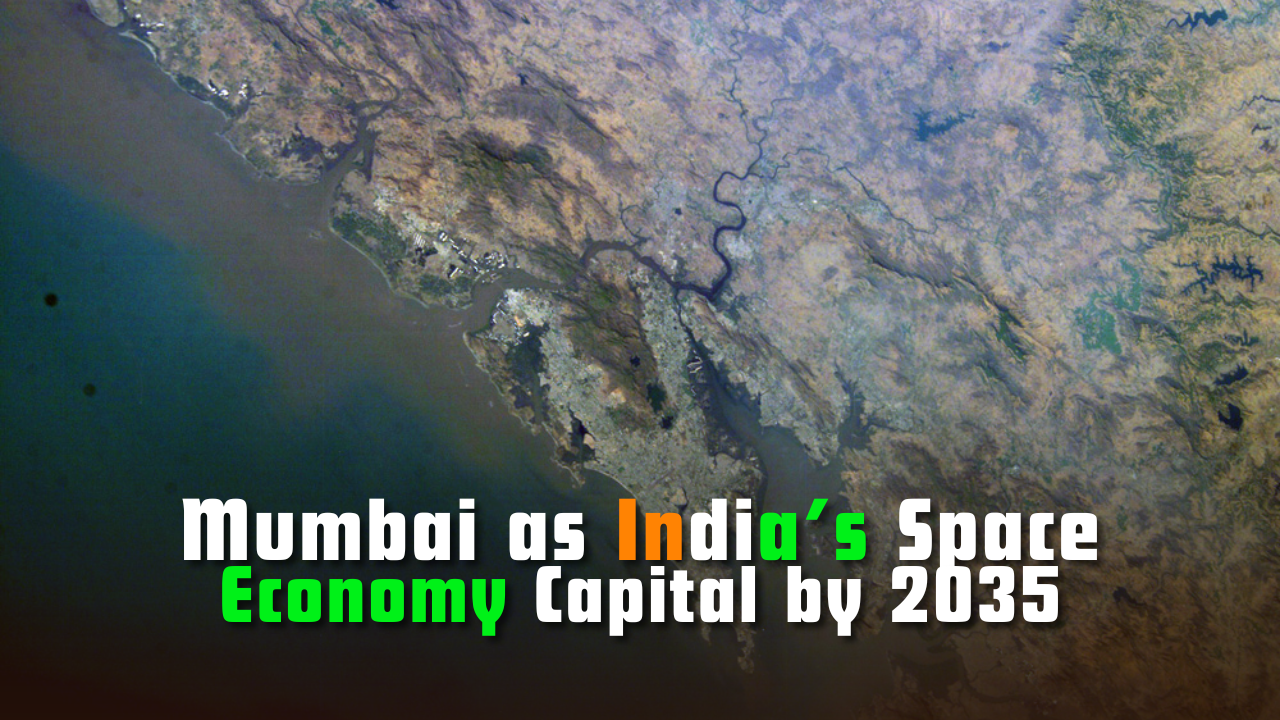Will Mumbai become India’s Space Economy Capital by 2035?
Explore how Mumbai can lead India’s space economy by 2035 through satellite data services, digital tech, and self-reliance-focused downstream strategy.

Mumbai: India’s Capital of the Space Economy
In 2020, the Indian government introduced major new rules for the space industry. Then, in 2023, it published the National Space Policy. Since then, several states—like Tamil Nadu, Telangana, Karnataka, and Gujarat—have created their own space plans. These changes are driven by two big things: new rules that allow more foreign investment, and a dream to share in the growth of the world’s space economy. Today, that economy is worth about US $650 billion. Experts think it could grow to nearly US $1 trillion by 2035 (Chaitanya Giri, “Making Mumbai India’s ‘Space Economy’ Capital”, ORF, July 18, 2025).
Maharashtra, the state that contains Mumbai, has said it will make a state space policy under Chief Minister Devendra Fadnavis. But so far, it has not decided what it wants to focus on. The big question is: should Maharashtra build large facilities to design and launch rockets and satellites—like the states that work closely with ISRO, India’s national space agency? That would require a lot of money and outside investment, which might be hard to come by. Or should Maharashtra use Mumbai’s strengths in data, technology, money, and global connections to build a new type of space plan centred on services?
Chaitanya Giri argues in his ORF article that Maharashtra should choose the second path: use satellite data and technology services. This essay agrees. It says that Maharashtra should focus on downstream space activities—like geospatial data, satellite communications, digital twins, and blockchain asset systems—while staying self-reliant (“atmanirbhar Bharat”). By using Mumbai’s strong digital and financial infrastructure, the state can become India’s champion in space services. This plan could also help India achieve its strategic goals in space.
Strategic Specialisation
Maharashtra’s space plan should emphasise downstream applications—these are services and technologies that use what satellites already provide. Examples include:
- Geospatial analytics: analysing maps and locations using satellite data.
- Satellite communications (satcom): linking satellite signals to phones, internet, and other services on land.
- Digital twins: creating virtual copies of cities, factories, or systems to test ideas digitally before building them in real life.
- Blockchain platforms: using secure, digital ledgers to track and manage assets that relate to space data.
These are very different from upstream work, such as building rockets or launching satellites. That requires large factories, heavy engineering and close links with ISRO, and could involve high costs and risks.
Mumbai is already strong in areas like telco networks and artificial intelligence (AI). It makes sense for Maharashtra to focus on the space services that rely on those strengths, rather than repeating what ISRO-linked states are already doing.
Giri puts it well: “Maharashtra must adopt a different approach … not spend efforts attracting the same investors and manufacturers who intend to be in states with ISRO installations … Maharashtra should bank on being the farthest from ISRO.” (ORF, 2025) In other words, Maharashtra should not copy others. It should use its own advantages to build something new.
Ecosystem Advantage
Mumbai is already known as India’s business and finance capital, but it is also becoming a tech hub. It has strong computer and digital infrastructure, many people working in data and AI, global communications links, and a rich financial ecosystem.
Because of this, Mumbai can support projects that use satellite data without needing to build expensive rocket launchers. These projects might include:
- Risk management: using maps and AI to predict weather disasters or investment problems.
- Supply chain intelligence: tracking goods in real time using satellite data.
- Asset tokenisation: representing physical or digital assets on blockchain networks, making them easier to own, trade, and manage.
Giri describes this vision clearly: “Mumbai … poised to become the country’s ‘data and AI capital’ and a major global hub … use of geospatial data for risk management, market and supply chain intelligence … tokenisation of assets using blockchain-based … space platforms.” (ORF, 2025) This shows how well Mumbai’s tech and finance strengths fit with the kinds of services that satellites enable. These areas offer high value without needing heavy investment in buildings or launch systems.
Downstream Over Upstream
There are two important reasons why Maharashtra should focus on downstream space services instead of upstream space hardware:
- Foreign investment in upstream projects is limited Space is a sensitive industry. Many countries do not allow or limit foreign money in building rockets or military satellites. India’s current policies also encourage self-reliance (“Aatmanirbhar Bharat”). That makes it hard to bring in outside funding for upstream projects.
- Mumbai is already strong in downstream skills With many experts in finance, data, AI, and global communications, Mumbai has the perfect mix of talents needed for satellite services, data analytics, and blockchain applications. These are much closer to what companies there already do.
By choosing downstream work, Maharashtra can build its space economy without needing massive launch facilities. This reduces costs and avoids certain strategic risks. It helps Mumbai become a centre for modern space services.
Questioning Over‑Optimistic Forecasts
Some people say that India’s share of the global space economy could reach 8 per cent by 2035, or that the total global space economy itself will be worth US $1 trillion. These statements are based on predictions from consulting firms. Such forecasts can be useful because they are bold goals—but they are not guarantees.
It is vital for decision-makers to understand that these figures are hopes and goals—not firm facts. Policies and actions should be based on solid evidence and realistic planning. Ambitious targets can inspire hard work, but unless they are balanced by careful study and reliable data, they may lead to problems in the future.
Recommendations
To help Maharashtra shift to this downstream-focused space economy, here are six clear recommendations:
- Adopt a Downstream‑First Strategy; Focus on services that use satellite data—especially geospatial analysis, satcom connections, digital twins, blockchain-based assets, and AI. Do not build factories to make satellites or rockets unless there is a clear, strong reason.
- Promote Self‑Reliance; Encourage Indian companies and startups in space technology. Make sure the economic value created stays within India, supporting national independence and local jobs.
- Integrate Policies: Connect the state space plan with other policies on information technology, financial technology (FinTech), electronics manufacturing, innovation, exports and startups. This will create a powerful support network in different sectors.
- Place Governance in the Chief Minister’s Office; Make the Chief Minister’s office responsible for overseeing the space economy. This will ensure strong political leadership, cooperation between departments, and real decision-making power.
- Use Mumbai’s Digital and Telecom Infrastructure: Mumbai has many underwater cables that deliver internet around the world, a high level of mobile and data services, and lots of tech experts. Use this foundation to build SAGIN (Space Air Ground Integration Network) systems—these combine satellite data with ground networks. This can be used for things like disaster warning, driverless transport, and predictive services.
- Be Careful with Upstream Engagement: If Maharashtra decides to work on building satellites or launch systems, it should do so only when it serves national strategic needs. Any foreign partnerships or private investment should help India’s goal of self-reliance.
Conclusion
Mumbai already has the key ingredients it needs to lead India’s downstream space economy: excellent digital infrastructure, strong financial markets, skilled workers, and global connections. By moving away from copying the upstream space factories of other states and focusing on its own strengths in data, analytics, AI and communications, Maharashtra can form a space strategy that is truly its own.
Such a strategy would not only support India’s dream of capturing 8 per cent of the global space economy—it would also help the nation become more technologically independent and build a space sector with lasting benefits. By staying focused on what it does best, Mumbai is well placed to become India’s capital of the space economy—not by copying others, but by forging its own path that fits its abilities and the country’s self‑reliant future.
Subscribe to our Youtube Channel for more Valuable Content – TheStudyias
Download the App to Subscribe to our Courses – Thestudyias
The Source’s Authority and Ownership of the Article is Claimed By THE STUDY IAS BY MANIKANT SINGH





